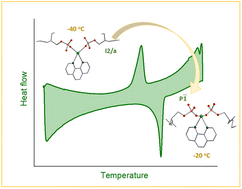A rigid calcium 2-ethylhexylphosphate one-dimensional polymer: synthesis, structure, thermal behaviour and decomposition chemistry†
Abstract
The reactivity of two different phosphate esters has been explored with calcium ions. The reaction of calcium oxide with a mixture of mono/bis 2-ethylhexyl phosphate and 1,10-phenanthroline leads to the formation of the 1-D polymer [(phen)Ca(ehpH)2]n (1). On the other hand, the reaction of Ca(OAc)2 with trimethyl phosphate in the presence of 1,10-phenanthroline however yields needle-shaped colourless crystals of [(phen)Ca(OAc)2]n (2). Compounds 1 and 2 have been characterized by various spectroscopic and analytical techniques. The solid-state structures have been determined by single crystal X-ray diffraction studies. The arrangement of rigid and flexible parts in 1 makes it an interesting compound to be studied for its thermal behaviour. DSC experiments performed above and below room temperature reveal thermal transitions in both the ranges, where below room temperature transition is prominent. A combination of variable temperature powder and single crystal X-ray diffraction experiments provides further insights into these transitions. Solid-state bulk thermolysis of 1 at 500 °C leads to an amorphous material contaminated with graphitic carbon which upon further heating to 600 °C produces crystalline α-Ca(PO3)2.



 Please wait while we load your content...
Please wait while we load your content...